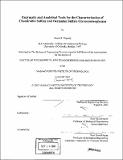Enzymatic and analytical tools for the characterization of chondroitin sulfate and dermatan sulfate glycosaminoglycans
Author(s)
Pojasek, Kevin R. (Kevin Robert), 1976-
DownloadFull printable version (12.32Mb)
Other Contributors
Massachusetts Institute of Technology. Biological Engineering Division.
Advisor
Ram Sasisekharan.
Terms of use
Metadata
Show full item recordAbstract
Glycosaminoglycans (GAGs) are complex polysaccharides that reside in the extracellular matrix and on the surfaces of all cells. The same complexity that contributes to the diversity of GAG function has also hindered their chemical characterization. Recent progress in coupling bacterial GAG-degrading enzymes with sensitive analytical techniques has led to a revolution in understanding the structure-function relationship for an important subset of GAGs, namely heparin/heparan sulfate-like glycosaminoglycans (HSGAGs). The study of chondroitin sulfate and dermatan sulfate (CS/DS), an equally important subset of GAGs, has lagged behind partially due to a lack of enzymatic and analytical tools akin to those developed for HSGAGs. The Flavobacterial heparinases have proven indispensable in characterizing the fine structure of HSGAGs responsible for their different biological functions. As a continuation of ongoing research, a combination of chemical modification, peptide mapping, and site-directed mutagenesis was employed to explore the role of histidine in the activity of heparinase III. Of the thirteen histidines in the enzyme, His295 and His510 were found to be critical for the degradation of heparan sulfate by heparinase III. As a first step to developing the chondroitinases as enzymatic tools for the characterization of CS/DS oligosaccharides, recombinant expression and purification schemes were developed for chondroitinase AC and B from Flactobacterium heparinum. The recombinant enzymes were characterized using biochemical techniques and kinetic parameters were determined for their respective CS/DS substrates. (cont.) By combining the modeling a tetrasaccharide substrate into the active site of chondroitinase B with site-directed mutagenesis studies, a variety of residues were identified as critical for substrate binding and catalysis. A subsequent co-crystal structure of chondroitinase B with DS-derived hexasaccharide revealed a catalytic role for a calcium ion and provided further clarity into the role of individual active site amino acids. Additionally, using a variety of defined DS-derived oligosaccharides coupled with sensitive analytical techniques, chondroitinase B was identified as an endolytic, non-random, non-processive enzyme that preferentially cleaves longer oligosaccharides compared to shorter ones. Taken together, these studies represent a critical step in developing the chondroitinases as enzymatic tools for the characterization of CS/DS oligosaccharides in a fashion akin to the use of the heparinases to characterize HSGAGs.
Description
Thesis (Ph. D. in Applied Biosciences and Biotechnology)--Massachusetts Institute of Technology, Biological Engineering Division, 2003. Includes bibliographical references (p. 113-123).
Date issued
2003Department
Massachusetts Institute of Technology. Department of Biological EngineeringPublisher
Massachusetts Institute of Technology
Keywords
Biological Engineering Division.